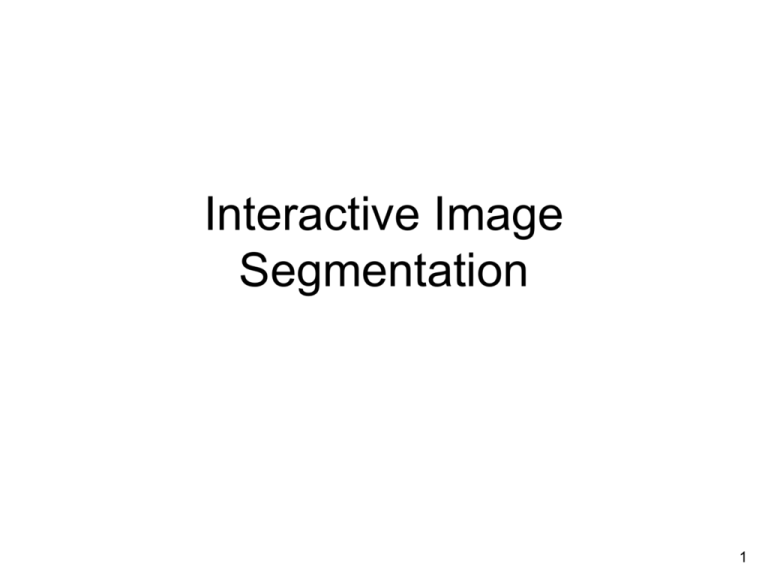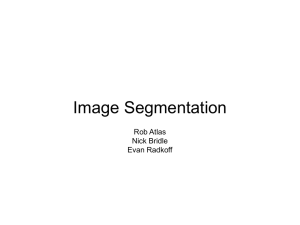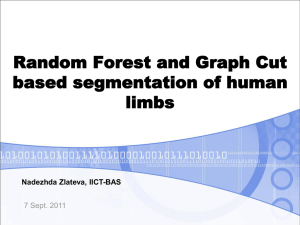Interactive Image Segmentation
advertisement

Interactive Image
Segmentation
1
Image Segmentation Problem
• Segmentation refers to the process of partitioning an
image into multiple non-overlapping segments
• The goal of segmentation is to simplify and/or change
the representation of an image into something that is
more meaningful and easier to use.
• Image Segmentation is a traditional Computer Vision
problem. However, it is also an ``unsolved’’ problem.
• Problem of Automatic segmentation:
– Different segmentation method favors different criterions
– Different applications / human have their own different
segmentation criterions
– An universal segmentation algorithm does not exist
2
Interactive Image Segmentation
• Different user has different preferences on segmentation
• Why don’t we ask user to guide the segmentation
process ? Interactive Image Segmentation
• Goal is to provide an intelligent tool that minimize the
amount of user’s works
• Topics in this class
– Image Snapping [Siggraph’95]
– Intelligent Scissors [Siggraph’95]
– Lazy Snapping [Siggraph’04]
• Extra reading materials
– Grabcut [Siggraph’04]
– Paint Selection [Siggraph’09]
– Video Snap Cut [Siggraph’09]
3
Image Snapping
• SIGGRAPH, 1995
– Michael Gleicher, Apple Computer in 95, now
Assoc. Prof. at U. Wisconsin
• Idea
Cursor snapping is a technique that helps a mouse “snap” to a
widget
• The cursor is the pointer device used in “direct manipulation” type of
user interfaces (Windows is a direct manipulation interface)
• In many graphics applications (esp CAD/CAM), the mouse will
“snap” when it gets close to a button or object
• This allows the user not to be so accurate
Image snapping
• Have the mouse cursor snap to image features
– Same idea, you don’t have to be very precise
4
Image Snapping – figures from paper
Snapped Mouse position
position
5
Basic Idea
?
User clicks
on an image
point.
How do we find “feature” to snap to?
6
Basic Idea
?
Naïve approach?
Search in a “spiral” pattern, increasing in distance from the point,
7
until “something” is found.
Problems with Naïve Approach
• No method for rejecting noise
• Needs a preset stopping criteria
• No way to trade off certainty and size for
distance
• Stops at first feature it finds, a better
feature may be equal distance away
CAN WE DO BETTER?
8
Image Snapping Approach
• Consider the “feature map” as a height-field
• Follow the feature map gradient (1st derivation) from
point position until we find a suitable feature
Analogy: Point is a ball. Drop it and let it roll down the hill
until it finds a stopping place.
1D example:
Similar in idea to numerical “gradient decent” methods.
http://mathworld.wolfram.com/MethodofSteepestDescent.html
9
Snapping Approach
• Search follows gradient
• Stopping criteria is where we can’t search
in a downward direction anymore
Sharp images can cause problems.
Blur image to make gradients smooth.
10
Blurring Image First
• Blurred image helps remove noise
• We can blur at different amounts, this can
help the level of detail we want to snap too
Input
blurred
blurred more
11
Basic Algorithm
• Input image -> feature map
– Blur image -> apply sobel mask -> get gradient map
• Finding a feature (snapping)
• When mouse is clicked
– Follow gradient path until we find a “minimum”
• Minimum is where there is either no more gradients (constant
region)
• Or the gradients are very different (line)
– If no minimum is found within a certain distance, stop
search too (nothing to snap too)
12
Image Snapping
• Gradient Map
Click here
and follow
the gradient.
Note that the
original image
has been blurred.
2-pixel black line
is now gray.
One problem is that
stopping position may
be between 2 pixels.
(that is, not aligned on
13
a pixel)
Alignment issues
We can compute “sub-pixel” accurate snapping. Or we can
force the snapping to be on a pixel.
14
Sub-pixel Snapping
Yellow line:
Sub-pixel snapping
Green line:
what the user
draws
15
Adding Hysteresis
• One problem is that the snapping has no
“memory” of where it snapped last
• If you are tracing, this can cause the
cursor to jump around
• A kind of “hysteresis” can be introduced
that gives preference to the last feature
snapped too
Hysteresis def: “History dependence of a physical system”
16
Example
Without adding
Hysteresis effect
With
Hysteresis effect
17
How to Add Hysteresis?
• The idea is to pull the snapped cursor instead of snap
from the input cursor
– Potential problem
• If you pull the cursor too much, it may jump to the wrong place
• If you pull too little, it will snap back to the starting place
– Solution
Initialize: Δp=1
Initial snapped cursor position (x,y)
Step 1: Pull Δp-pixels towards the user-cursor
if it snaps back to (x,y)?
Δp=Δp+1
goto Step 1:
else
you have the new (x,y) position
old position
new position
Δp
move
18
Image Snapping Summary
• Interesting idea aiding the user’s image
manipulation
• Reduces the level of accuracy
• Aid in “tracing” objects (Hysteresis + snapping)
• This is one of the early “Graphics meets Vision”
paper
– I recommend you read it, you’ll see how the author
describes many of the vision terms
– Now (more than 10 years later), SIGGRAPH readers
are assumed to have a much better background in
vision/image processing
19
Intelligent Scissors
• SIGGRAPH, 1995
– Eric Mortensen and William A. Barrett
• Idea
- Treat segmentation as a graph-search problem
- Between two starting points (which dynamically change)
- Find shortest path on the graph
- Path edge costs are related to image content
20
Segmentation as a graph path
problem
• Treat entire image as a graph
• Pixels are nodes, eight edges,e, between
every pixels
• Clicking on two points, you want to find the
minimum cost path between A and B
B
A
|| AB ||
|e|
eAB
21
Edge costs?
Edge cost are based on the image content. In particular,
gradient information (edge)
Thresholded 2nd Derivate
1st Derivate magnitude
(i.e. edge strength)
Similarity of gradient
direction between two
nodes
22
Pre-processing
• Edge costs are pre-computed when the image is loaded
• Requires 3x3 Laplacian and 2 3x3 Gradient (Sobel)
filtering to be performed
• Some additional calculations to compute the angle cost
(see paper)
Similar to the “Image Snapping”,
authors mention blurring image first.
23
Shortest path
graph algorithm.
Note that this
produces a spanning
tree from the seed point
s, to all nodes
in the graph!
Also see: http://en.wikipedia.org/wiki/Minimum_spanning_tree
24
Example of spanning tree expansion
Initial input (with costs)
Technically costs
should be edges, not pixels
First step of algorithm,
all edge cost to the
seed point are computed.
[Note that diagonals are
being waited by sqrt(2),
thus 8 becomes 8*sqrt(2)=11]
List L, now has 8 nodes on it (see algorithm)
L = {1, 2, 4, 7, 7, 7, 11, 13} // these represent cost, but they are also linked back
// to the pixel that they represent. (list is sorted!)
25
Example of spanning tree expansion
Minimum cost,
place at the top
of the list, lets
call this “r”.
Now all costs through
“r” are computed.
Recompute all costs.
Notice,these pixels
changed their
cost. Its cheaper
for them to go this
way than diagonal
(see first expansion).
Their cost have to
change in list L too.
Expansion 1:
L = {1, 2, 4, 7, 7, 7, 11, 13}
Expansion 2:
L = {2, 4, 5, 6, 6, 7, 7,9,13,14} // new list afterwards. Look very
// carefully
Remove lowest value,
and expand by unvisited
neighbors
26
Next Several Expansion
Next several expansions by “2”, “4”, “5”
Final expansions.
Note, we now have a path from
every pixel back to the seed “s”.
27
Live Wire
User clicks
a seed point.
- spanning tree is
quickly calculated.
Then moves the
mouse to “free points”.
The ‘wire’ magically
find the path based
on spanning tree.
28
Have you seen this before?
Photoshop “magnetic lasso”
29
Some tricks for improvement
• Hard to specify the initial seed point on the objects
boundary
– So, “snapping” is used to snap the first seed point
• Periodically, a new seed point is automatically
introduced (which re-computes the spanning tree).
– This is called “cooling”
30
More tricks
• Dynamic training (or feature cost
adjustment)
Wire keeps snapping to
man’s shoulder because it
is darker (stronger gradient)
Adjust (normalize) all gradient
close to the live-wire (in a local region)
to strengthen them. This allows the
wire to snap back to the face.
31
Some results
(final output)
32
Intelligent Scissors Summary
• Effective tool for object extraction
• Combines real-time graph-search with user interactive
(and updating)
• Adopted by Photoshop (with variations I’m sure)
• Is it better than Image Snapping?
– Notice they were published at the same conference, same year.
33
Lazy-Snapping
• SIGGRAPH, 2004
– Yin Li, Jian Sun, Chi-Keung Tang, Harry Shum
• Idea:
– Problem with Image-snapping and Intelligent Scissors?
• You still need to trace the object
• This takes time
– Can we do better?
• How about just supply very rough scribble to denote the background
and foreground? (this is lazy)
input
markup
output
34
Treat object extraction as a 2-class
classification problem
background
foreground
Each pixel in the image should
be labeled as either “background” or “foreground”
Result
35
Training examples via markup
B
F
G
R
B
n F pixels
Result: m B pixels
Pixels along user-scribble provide
“supervised” RGB training-data
Blue = background (B), yellow = foreground (F)
36
Simple 1-NN Classifier
Given an unlabeled pixel, C(i).
Decide whether is background
or foreground.
?
B
F
G
R
B
Compute new pixels RGB Euclidean
distance (L2-norm) to all labeled B pixels,
and all labeled F pixels.
Select nearest from each.
37
Assigning a score
• For each pixel, we can assign a score that this pixel is
either foreground or background. We will use these
scores to “minimize” a function, so the lower the score
the more confident a pixel is to below to a class.
Notation of the following equation:
xi is a pixel label (not its color). 1=foreground, 0=background
E1 is the score
F, B represent the training-data (already labeled). U are unlabeled/uncertain pixels.
Read carefully. Pixel that is already labeled as foreground has
a score of 0 for being foreground, infinite as being labeled background.
Background pixels are defined similarly.
Uncertain regions
38
Adding a Markov Random Field
• The per-pixel score is not enough
• To perform the final labeling, an MRF is used – this
enforces spatial constraints
MRF Nodes
MRF
Edges
Cost for labeling a node is E1(xi)
(as defined on the previous slide)
Node cost often called the “data cost” or
“likelihood energy”
Edges have to vertices xi and xj.
Cost for an edge depend on what labels
are assigned to xi and xj.
This is a graph,
with {V,E}
V = nodes (vertices)
E = edges
We will call this cost E2(xi,xj)
(defined on next slide)
Edges cost often called “smoothness term”,
or “smoothness prior”, or “prior energy”
Excellent MRF code: http://vision.middlebury.edu/MRF/
39
Edge Costs
where
Possible Edge Configurations and cost:
Configuration 1
F
B
1/[Color Difference]
Small Color Difference = Large Cost
Large Color Difference = Small Cost
(Ask yourself why?)
Configuration 2
F
F
Cost = 0
|1-1| = 0
Configuration 3
B
B
Cost = 0
|0-0| = 0
40
How Edge Cost work
x9
B
B
?
F
B
?
F
F
B
x10
If color difference
is large, then
cost (B,F) = small
If color difference is
small, then
Cost (B,F) = large
x11
?
F
F
Label ? with
The value that
results in the
smallest cost
For:
E(x9,x10) and
E(x10,x11)
41
Solving MRF
• Put all of these costs together and find the
optimal labeling for the whole network
?
B
?
?
?
?
B
?
F
?
?
?
Remember, some points are
already labeled (from markup),
so they are fixed.
Solution is the label set that minimizes
cost function E(X).
Solution is often an approximation.
Many approaches for solving
minimizing MRF E(X).
42
Speedup up the computation
Labeling an MRF by each pixel is slow
– Will not allow for interactive rates
Here, each pixel is
a V, and there are
edges between all pixels
Speed up?
–First segment the image into larger
regions
–Use the “watershed algorithm” to
pre-segment
–Nodes are the centers of the watershed
Here, only the centers of the
segmented regions are V, and the
edges are the connection.
Presumption is that the segmentation
preserves boundaries well.
43
Clean up
• This classification using MRF is not perfect
• Any mistakes can be corrected manually
• Li et al introduce a “boundary editing” approach to help
– It allows the user to draw the boundary, pixels re-labled near the
boundary
– Edge energy is modified to incorporate the drawn boundary
• Only pixels within the “yellowish” region are processed
• (See paper for more details, you should be able to understand it based on
the notes)
44
Final Results
Demo.
45
Lazy Snapping Summary
• Scribble based segmentation
– Very fast and intuitive
– Avoids having to get too close to the edge
• This scribble user interface have been used in
many later applications
• Extended to Video Snapping in next year
Siggraph
• A continue work of “Paint Selection” based on
instant feedback and multi-core computation
published in this year Siggraph
46
Summary
• We’ve discussed some computeraided/user-assisted approaches for
interactive image segmentation
• Combine computer-vision/image
processing with user-assistance
– Some people are calling this “Interactive
Computer Vision”
• Greatly helps the processing of photos
47






